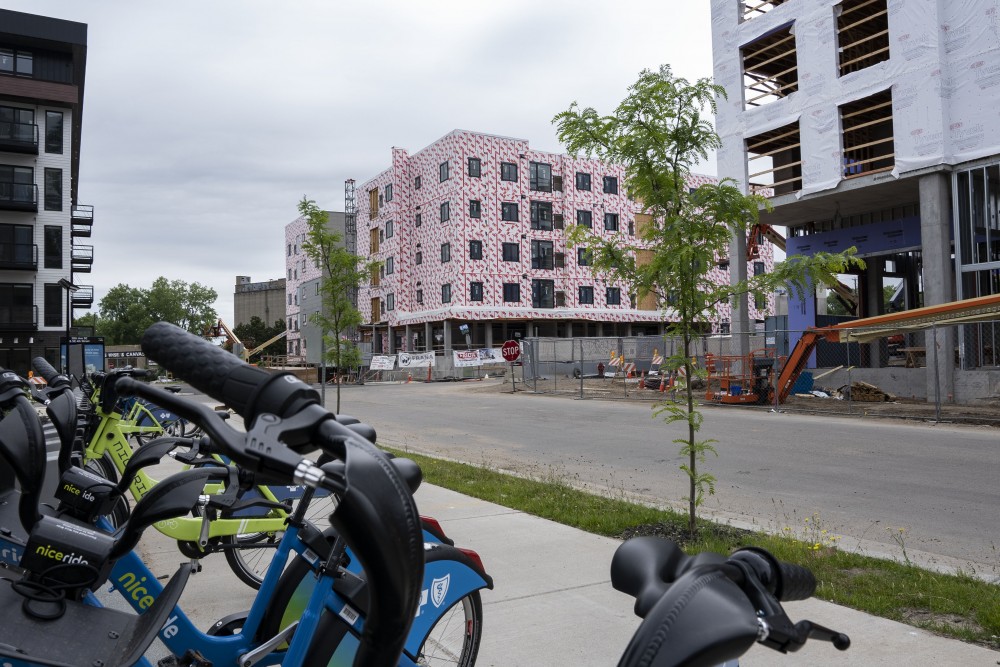A bold plan is underway to supplant a graveyard of industrial ruins and create a dynamic and dense neighborhood on the north side of University Avenue Southeast in Prospect Park.
Towerside Innovation District is the first of its kind in the state and could pave the way for the redevelopment of similar underutilized areas around the city. The Metropolitan Council has awarded nearly $12 million for the region since 2004 for cleanup, site investigation and development.
‘Innovation districts’ are areas which typically connect anchor institutions — such as the University of Minnesota — with startups and incubator spaces for small businesses. They are population-dense with transit accessibility and an emphasis on walkability, typically offering a variety of mixed-use housing and amenities, according to research from Brookings Institute.
The district has added 2,760 housing units since 2014, including 560 affordable units and 524 units geared toward senior citizens. Some of these projects are still in progress, such as the Malcolm Yards mixed-use housing and food hall development.
The estimated total investment to the region for housing, non-housing and infrastructure is around $1 billion, said Stephen Klimek, Towerside’s project manager.
“We think that’s part of building a healthy, sustainable, diverse community, is providing a range of housing options, providing a range of job opportunities, ideally, as well,” Klimek said.
Over $700,000 of a Metropolitan Council grant is currently passing through the city of Minneapolis. The funds will create pedestrian improvements around the Prospect Park Green Line light rail station and the nearby developments, such as the Green Fourth Street project, which Towerside leaders say exemplifies part of their vision.
“It all kind of comes together in this idea of what Green Fourth Street is as a pedestrian-friendly car-tolerated public space,” Klimek said. “[It] is really kind of lush, well-planted, has placemaking elements and things to do on the street.”
Since the 2014 opening of the Prospect Park light rail station, the 370-acre district has drawn greater attention from developers and a variety of stakeholders.
More concentrated development requires less land and can use resources more efficiently, leading to environmentally sustainable growth and greater fiscal efficiency, said Jennifer Vey, a senior fellow with Brooking Institute’s Metropolitan Policy Program.
“It also promotes better opportunities for economic growth and, ideally, more inclusive economic growth,” Vey said.
Minneapolis passed a 2015 resolution recognizing Towerside and the concept of other innovation districts. The work in Towerside may influence other underutilized parts of the Twin Cities, such as Upper Harbor Terminal in North Minneapolis or the Ford site in St. Paul.
Some of their work has already laid the foundation for nearby projects. The Towerside District Stormwater System is a collaboration between multiple landowners — a first-of-its-kind system of private owners sharing a piece of infrastructure — which helped set the legal framework for Allianz Field’s stormwater system in St. Paul.
Vince Netz, a member of Towerside’s board of directors, said the vision is gaining momentum with recent developments. The team is currently considering how to bring more jobs and greater investment to the area, and he said they’re constantly exploring what ‘community’ means for Towerside.
“There’s a housing crisis, there’s a climate crisis, there’s an equity crisis going on in Minneapolis right now … how can Towerside help address that in terms of community?” Netz said. “There are a lot of people that live outside of this that are going to be moving here in the next 10 years. How do we engage with that?”














